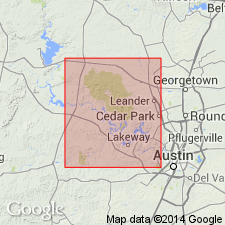
- Usage in publication:
-
- Cedar Park member
- Modifications:
-
- Original reference
- Dominant lithology:
-
- Limestone
- AAPG geologic province:
-
- Ouachita folded belt
Summary:
Pg. 239, 331. Cedar Park member of Fredericksburg group. South of Florence, Williamson County, Texas, much of position of the Walnut [clay] is occupied by a limestone lentil here designated Cedar Park member. It occurs over a considerable area in western Williamson County and grades out northward into Walnut of type facies. It consists typically (field work of H.C. Fountain) of about 58 feet (in core tests) of limestone, crystalline and porous above and more marly and nodular below. Upper 15 feet is a solid, medium-grained, grayish limestone weathering yellow, with a few scattered fossils. This is underlain by a few feet of porous limestone with fossils. The basal member is somewhat nodular and fossiliferous. The base is 5+/- feet of typical Walnut marl with many EXOGYRA TEXANA and other usual fossils. These 3 portions are exposed in a facies transitional to type Walnut on bluffs of the South San Gabriel at highway crossing north of Leander, where they overlie the Glen Rose. In Cedar Park area the limestone lentil in basal Fredericksburg reaches 125 feet in thickness and probably covers several sq mi. Age is Early Cretaceous (Comanche).
Type locality: quarries about 2 mi northwest of Cedar Park, Williamson Co., east-central TX.
Source: US geologic names lexicon (USGS Bull. 896, p. 383).

- Usage in publication:
-
- Cedar Park member
- Modifications:
-
- [Revised]
- AAPG geologic province:
-
- Ouachita folded belt
Summary:
Pg. 24. Cedar Park member of Walnut clay of Fredericksburg group. Thickness 10 feet or less. Age is Early Cretaceous (Comanche).
Source: US geologic names lexicon (USGS Bull. 1200, p. 691).
For more information, please contact Nancy Stamm, Geologic Names Committee Secretary.
Asterisk (*) indicates published by U.S. Geological Survey authors.
"No current usage" (†) implies that a name has been abandoned or has fallen into disuse. Former usage and, if known, replacement name given in parentheses ( ).
Slash (/) indicates name conflicts with nomenclatural guidelines (CSN, 1933; ACSN, 1961, 1970; NACSN, 1983, 2005, 2021). May be explained within brackets ([ ]).

